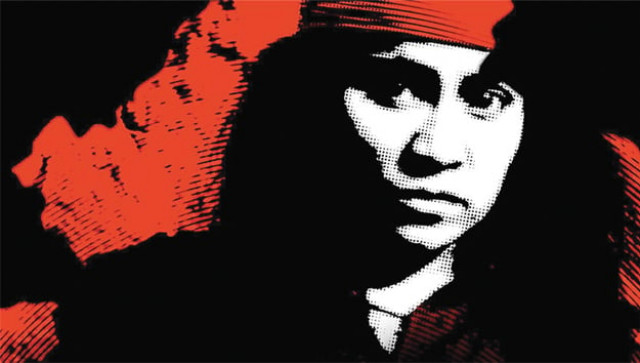Bollywood's women: Caught between idol and item?
While there may be fewer rape scenes in Hindi films today, the industry continues to objectify women.

The darkened cinema is the space where desire is explored without fear. Each member of the audience can privately lose themselves in the moving image projected onto the great glowing screen in front of them. And over the decades, Bollywood has given us symbols of desire that have ranged from the siren to the scrubbed village lass to the struggling young widow.
Indeed, as Talaash (2012) proved, we can even be lured into the arms of a phantom even as we fear annihilation lurking beneath her papery skin.
But desire has its daemons too.
And the other end of frustrated desire is the social crime of rape. Bollywood has certainly not shied from this type of violence. The symbols are familiar, repeated in film after film — the broken anklets, the ripped sari blouse at the shoulder, the clap of thunder and shards of lightening. A shaking hand stretched across the mandir’s threshold.
A rape scene was invariably part of any commercial Bollywood film from the 1970s onwards. It was plotted as the villain’s final, unforgiveable act that then neatly dovetailed into a justification for the hero’s subsequent obsession with vengeance.
“The social fabric at the time was such that people were identified [by] the part they played within a family — husband, father, son, and wife,” explains popular poet and scriptwriter Javed Akhtar, who along with Salim Khan, scripted some of the blockbusters of that time such as Zanjeer (1973) and Deewar (1975). “In that context, what [could] be the greatest source of humiliation other than hurting the hero’s sister in the most vulnerable circumstances?” The hero’s moral outrage allowed us to forgive the slaughter that would follow.
The portrayal of rape mirrored the morality of the day. “Earlier, [at] a certain level, the morality was very black and white,” says Reema Kagti, who is among the new generation of filmmakers and has directed Honeymoon Travels Pvt Ltd (2007) and Talaash, both of which feature offbeat plots with strong female characters. “The rape scenes were there for titillation,” she adds. “That’s why every film had one. In today’s films, the item number is the equivalent of [the] rape [scene].”
A strong indictment but simply an accurate analysis that while times may have changed and there may be fewer rape scenes in Hindi films today, the industry continues to objectify women. How else, argues film editor Deepa Bhatia, who has worked on My Name is Khan (2010) and Rock On!! (2008), can we explain Katrina Kaif dancing to ‘Chikni Chameli’ like a Barbie doll? “She is saying look at me. It is commodification and that is the way it is,” says Bhatia. “You needed to show flesh under some pretext. Now heroines are item girls so everything is up for grabs.”
The problem though, many believe, goes beyond that. It lies is in the subliminal message packaged in suggestive songs and saucy dialogue. It persists in the age-old picturisation of romance: the man relentlessly pursuing the woman, who after rejecting his advances, finally gives in. “Films unintentionally give respectability to the term eve-teasing,” admits Javed Akhtar. “It makes the act seem innocent when it is not. They show the hero singing and following the woman to woo her even when she says no and that gives credibility and sanction to the act of eve-teasing; [showing] that this is a part of love.”

The mixed message is part of the problem — not just because the woman dressed in western clothes is ‘asking’ for trouble but also because the ‘sati savitri’ innocent woman is also a target. This conveys that no matter what your persona, as a woman you are vulnerable to assault. As sociologist and film buff Shiv Viswanathan puts it: “The equation of western to immoral bothers me. The rape of the innocent, or not so innocent, this double gradient is what worries me.”
The objectification of women came under the scanner after the horrific Delhi bus rape in December. Some actresses, among them Kareena Kapoor, Neha Dhupia and Ayesha Takia, have decided, according to industry sources, against doing item numbers in future projects.
In the very least, the tragedy has precipitated debate. On one end of the spectrum are the directors who have reacted sharply to discussion linking films to the incidents of rape and sexual violence across India. “Cinema has only been around for a 100 years; men have been treating women badly for much longer than that,” argues filmmaker and choreographer Farah Khan. “So how can one blame cinema for what is going wrong in our country today?” Kagti is equally dismissive and uses an example to question people who say viewing informs behaviour: “How come people don’t [emerge from the cinema] a little [more] honest [after] watching Munnabhai M.B.B.S. (2003)?”

Other voices in the industry, albeit smaller in number, call for greater introspection. “Cinema is such a huge influence, so how can you say attitudes are not shaped?” counters Deepa Bhatia. “It has such an impact when it comes to clothes or syntax. So it does affect the way you view women. In the 1980s, when Karisma sang ‘Sexy, sexy sexy, mujhe log bole’, it changed the way women were viewed in this country.”
It appears that filmmakers who wish to challenge the dominant themes can do so elegantly (see Not Herd Mentality). Javed Akhtar for one believes that Indian audiences are ready for films which show a more nuanced portrayal of women and relationships. He cites the success of films like Kahaani (2011), Zindagi na Milegi Dobara (2011) and Band Baaja Baarat (2010)
It appears, however, that a few films do not a successful trend make. “It is difficult to find financial backing for films that tell women’s stories,” says Kagti. “There may be one Kahaani, but there are thousands of male-oriented films. Audiences, and not just in India, are not interested in watching women-oriented films.”
Cinema is, after all, a business, a big business in India. And as Bhatia argues, as long as box office success remains the goal change is unlikely. “You can’t hold a gun to filmmakers and force them to change their perspective.”
Silence of the lambs:
Insaaf ka Taraazu (1980)
Zeenat Aman and Padmini Kolhapuri, who plays her sister, are raped by Raj Babbar. The entire scene reeks of lasciviousness. In one regrettably unforgettable shot, Zeenat’s character is shown lying on the ground as seen from between his knees
Zakhmee Aurat (1988)

Dimple Kapadia plays a cop who is gang raped but then exacts revenge by castrating rapists. Considered a B-grade film and a real low when it came to portraying women
Bandit Queen (1994)
Arundhati Roy eviscerated Shekhar Kapur for his cinematic portrayal of Phoolan Devi. He never met in the flesh but based his film loosely on Mala Sen’s book on her with many deletions. Among a slew of criticisms, Roy asks why the rape of a “nice woman (saucy, headstrong, foul-mouthed perhaps, but basically moral, sexually moral) — is one thing. The rape of a nasty/perceived-to-be-immoral woman, is quite another”.
Not herd mentality:
Ghar (1978)

About a young couple (Vinod Mehra and Rekha) whose domestic bliss is shattered when she is raped by four goons while they are returning from a late night film show. The entire scene is shot, however, through the rapists’ faces. One of the most sensitive picturisations of the crime in Hindi cinema
Hazaaron Khwaishein Aisi (2004)
The female lead (Chitrangada Singh) is raped by local cops when she is working in the remote areas of Bihar. The director spares us the gory details and conveys the trauma subtly. In fact, she is even shown going back to work in those areas. Unconventional, rare portrayal
Damini (1993)
About a woman (Meenakshi Seshadri) who fights to get justice for her domestic helper who is raped by her brother-in-law and his friend on Holi. The horror of the incident is again conveyed through the perpetrators, their coloured faces, without dwelling on the woman.
The author is a Mumbai-based independent journalist and communications trainer with over 17 years of experience in print and broadcast media, with main focus on public health, gender, human rights issues and how technology impacts people's lives.
Published in The Express Tribune, Sunday Magazine, April 21st, 2013.
Like Express Tribune Magazine on Facebook to stay informed and join the conversation.


















COMMENTS
Comments are moderated and generally will be posted if they are on-topic and not abusive.
For more information, please see our Comments FAQ